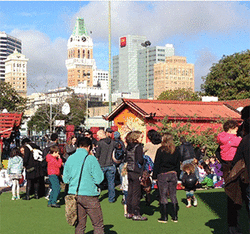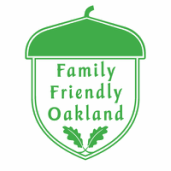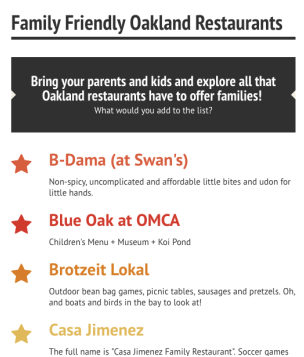
Last fall, the City of Oakland, Ca. launched a planning process to shape the future of its downtown. SPUR, a regional planning nonprofit, published a report titled, A Downtown for Everyone: Shaping the Future of Downtown Oakland. In it, the authors lay out bold recommendations focused on making Downtown more developer, transit, and business friendly.
As I read the report, one oversight really hit a nerve: there is nary a reference to making downtown more family friendly. In the report, the words “business,” “companies,” or “office” are used over 200 times. In contrast, “families,” “family,” or “children” appear only 10 times. Even San Francisco across the Bay got 88 mentions, and “parking” got big shoutouts—over 80 of them. A scan of other recent reports reveal similar and dismaying blind spots in our local planning efforts.
I moved downtown 13 years ago and for the last six of those years, my husband and I raised our two daughters and dog in a two bedroom condo in the Old Oakland neighborhood. We loved it because it’s an incredibly convenient and friendly place to raise a family downtown. We could bike our daughters to affordable daycare, walk to work, shop at small businesses and local farmers markets, and spend hours at the nearby public libraries and parks. Six generations of my family have grown up and grown old downtown, in and around Chinatown, but the reality is that while there have always been incredible family-friendly amenities and quality schools, there are hardly any family-sized housing options available nowadays.
So it’s no surprise that early last year we reluctantly moved to the edge of town where we could find a little more space for our growing girls. We traded our 2-kid hauler bike for a second car and more than tripled our commute time. But we’re not the only ones. Over the last 13 years, I've bid farewell to many families of all incomes being sized and priced out of downtown and the city altogether. Unfortunately, our current housing crisis has only accelerated the outward migration.
It’s been said that children are the indicator species of urban health and great neighborhoods, and by this measure, Oakland is in trouble.
As I read the report, one oversight really hit a nerve: there is nary a reference to making downtown more family friendly. In the report, the words “business,” “companies,” or “office” are used over 200 times. In contrast, “families,” “family,” or “children” appear only 10 times. Even San Francisco across the Bay got 88 mentions, and “parking” got big shoutouts—over 80 of them. A scan of other recent reports reveal similar and dismaying blind spots in our local planning efforts.
I moved downtown 13 years ago and for the last six of those years, my husband and I raised our two daughters and dog in a two bedroom condo in the Old Oakland neighborhood. We loved it because it’s an incredibly convenient and friendly place to raise a family downtown. We could bike our daughters to affordable daycare, walk to work, shop at small businesses and local farmers markets, and spend hours at the nearby public libraries and parks. Six generations of my family have grown up and grown old downtown, in and around Chinatown, but the reality is that while there have always been incredible family-friendly amenities and quality schools, there are hardly any family-sized housing options available nowadays.
So it’s no surprise that early last year we reluctantly moved to the edge of town where we could find a little more space for our growing girls. We traded our 2-kid hauler bike for a second car and more than tripled our commute time. But we’re not the only ones. Over the last 13 years, I've bid farewell to many families of all incomes being sized and priced out of downtown and the city altogether. Unfortunately, our current housing crisis has only accelerated the outward migration.
It’s been said that children are the indicator species of urban health and great neighborhoods, and by this measure, Oakland is in trouble.

